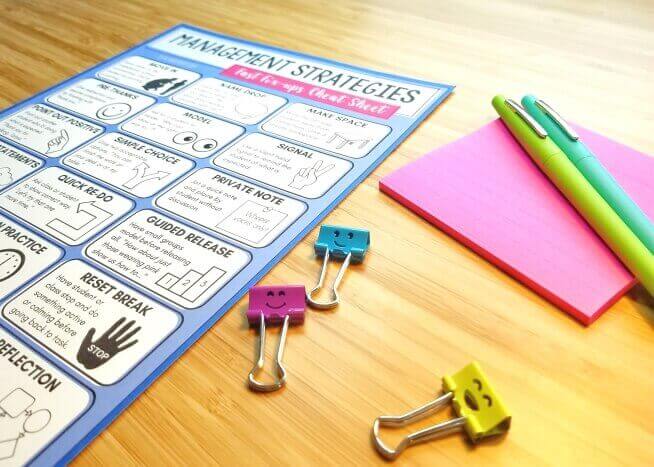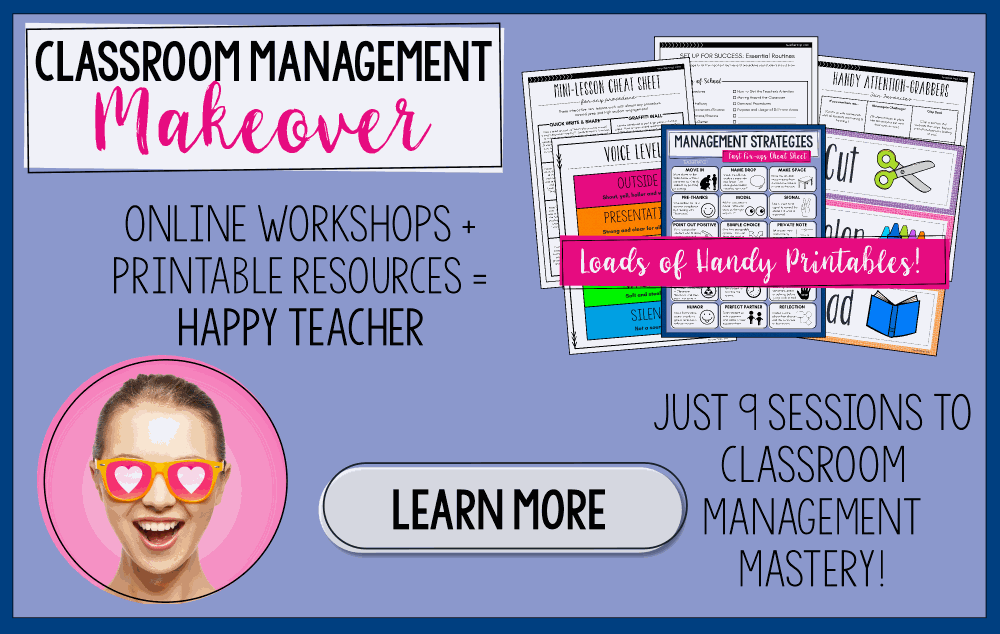Student behavior troubles notoriously skyrocket at the end of the school year, but it doesn’t have to be that way! I’ll tell you how to avoid the end of year chaos (with five simple changes) and how to set yourself up for an awesome next year!

1. You Are the Set Point
At the end of the year, teachers are TIRED. We’ve given all we’ve got and there’s simply not much left. Students pick up on these changes in your mood or attitude instantly! They’ll notice if you are a bit distracted or especially laid back or extra silly or a little grouchy, or any other out-of-character behavior, and respond in kind. You are the set point.
For many kids, a change in the teacher’s mood or attitude can trigger anxiety (leading to increased behavior issues). This change may also send the message that the accepted boundaries and expectations have changed, prompting a little extra mischief or silliness.
To maintain the peaceful and organized classroom you’ve worked so hard to create, you have to maintain your normal tone, mood, and habits with your students. If you relax too much, they’ll relax too much. If you stop holding them accountable, they’ll stop showing accountability.
If you send students the message that learning is over and summer break is here, you’ll spend your last weeks of school battling behavior rather than enjoying the fruits of your labor.
2. The Routine Rules
Every classroom has a daily flow of events that students come to expect and rely on. Routines provide an important sense of security for children and a predictable rhythm to the day.
When routines change, kids may feel excited, anxious, or downright out of control. At the end of the school year, it’s easy to let things slip. Special events and activities take over and soon you find yourself skipping morning meeting, running out of time for the end-of-day read aloud, or rushing through math in favor of a longer writing project.
Although the special events and activities will inevitably impact the daily routine, you can minimize the effects. First of all, stick to your normal schedule as much as possible, even if the activities within a part of the day look very different. This means that you follow the normal blocks of time that made up a standard school day throughout the year.
For example, let’s say students are working on a special group project during your math and writing block. Instead of just sending the kids off to work for that chunk of time, talk to them about how they’ll be working on the project during their Math block and that you’ll check in with them at the beginning of Writing time. Even though the activities don’t match, the blocks of time and general flow can feel familiar.

3. Increase Self-Directed Learning
During those last weeks of school, large group activities can be especially challenging. Kids are easily distracted, there are constant interruptions, and to be blunt, they just start to bug each other. It’s like siblings on a long car trip that get sick of one another.
My solution is to make more time and space for self-directed learning projects. The kids spread out around the room and focus on work that interests them while the teacher enjoys the peace and quiet.
My favorite projects typically include some kind of research component, a choice of topic, and a creative final product that kids are excited about. One of my favorites is this Zoo Project where students research an animal, create a booklet about it, and actually build a miniature habitat. You could also have students research states or important historical figures. The idea is to keep them actively learning while giving them space and independence.
4. Slow Down and Do It Again
This is the most obvious solution, but I know that when you’re in the thick of it, it doesn’t always seem so obvious because by the end of the year, we expect students to KNOW that expectations. We’ve lined up 800 times, so everyone should know exactly what to do without a reminder!
Unfortunately, it doesn’t work that way. To keep everything on track, it’s still important to slow down, review the expectations, and take time to practice if necessary. When we begin rushing through transitions, assuming students remember expectations, and allowing smaller problematic behaviors to slip by, things escalate quickly.
Treat those last weeks of school like the first weeks back after Winter Break. It’s important to slow down, review, and practice as needed. Check out 5 Quick Tricks for Getting Students to Follow Directions for some handy tips on getting things back on track.
5. Team Up
The end of the school year is hard, so why not recruit some much needed support! My saving grace has always been partnering with another class (or a few other classes) for special get-togethers and activities. Think of a teacher you could use some quality time with and then look for an activity that fits the bill.
One of my favorite partnerships was between my third graders and a friend’s kindergarteners. During the last few weeks of school, we’d spend thirty minutes every other day in her classroom so the kids could buddy up and do some partner reading. The kids loved it and it gave my friend and I thirty minutes of happy bonding time while everyone read quietly. It was a life saver!
Whatever you do, keep it simple. One year, my class buddied up with another for special technology lessons in the library (which the librarian volunteered to do!), while another year we met with a buddy class on the playground for science investigations. You get some time with a teacher-friend while the kids enjoy a unique and novel experience.
What About Next Year?
If you struggled with student behavior this year, you aren’t alone. “Classroom management” is consistently reported as being one of the most challenging aspects of teaching. And that’s why I created the Classroom Management Makeover Course. (Save 20% today with code CMMSAVE20)
Teaching shouldn’t be so hard and it doesn’t have to be. The goal of Classroom Management Makeover is to give you a new perspective on working with students, plus expert skills on managing even the most challenging behaviors.
Hundreds of teachers have enjoyed their management makeover and summer is the perfect time to sign up so you can feel positive and prepared for next school year!
“I’m currently working through the Classroom Management Makeover! I’ve been teaching for four years and classroom management has become more challenging! This is a super amazing tool that gives you resources and different ways of thinking about management. I’m in LOVE with it and actually excited to get back to school after ending my last year on a very sour note!” -Kebra















